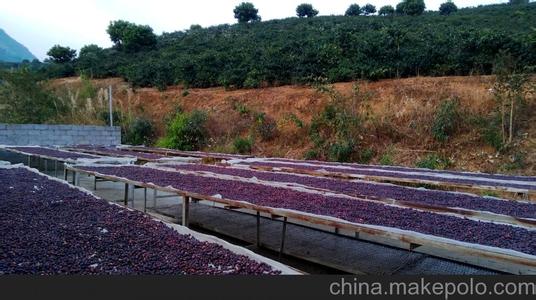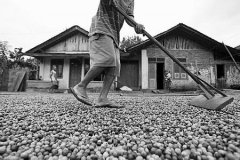A brief introduction to the treatment method of grinding degree and baking degree of aromatic Sidamo Shakiso boutique coffee beans

Shakisso/Shakiso is located in the Guji region of Sidama and is one of the micro-regions with very regional characteristics in Sidama. The coffee produced in this region is quite unique, and the coffee produced has repeatedly received market attention. Ninety Plus 'legendary bean (nekisse) originally means Nectar from shakisso, and its production area and name are all from shakisso.
Ethiopia is rectangular in shape, with a ratio of length to width of 3:2. From top to bottom by green, yellow, red three parallel equal horizontal rectangle composition, flag surface middle has the national emblem pattern. Since the late 19th century, Ethiopia has adopted a green, yellow and red striped flag. Ethiopia was the first African country in modern history to join the ranks of free peoples. [8]
By the 1950s and 1960s, many African countries had become independent one after another, and they adopted green, yellow and red as their national flags, so they were called "pan-African colors". Ethiopia is one of the ancient African countries, with a long history of more than 3000 years, giving green, yellow and red three colors a deeper origin in this land. Historically, they have been associated with the liturgy of the Coptic Church, enshrined as symbols of the Trinity of the Father, the Son and the Holy Spirit, embodying the three virtues of loyalty, hope and mercy advocated by human freedom. These three colors also represent three regions of Ethiopia: Tikrit (red), Amhara (yellow), and Theoya (green). Green represents fertile land, mild climate and abundant plant resources, but also a symbol of hope for the future; yellow symbolizes peace and fraternity, but also represents the people's determination to build the country; red symbolizes the people ready to shed blood to defend the motherland In 2000, since EPF came to power, it has created a federal system based on regional national autonomy, focusing on economic development and focusing on coordinating the relationship between stability, development and national unity. [1]
Constitution
On December 8, 1994, the Ethiopian Constituent Assembly adopted the fourth constitution, the Constitution of the Federal Democratic Republic of Ethiopia, which came into force on August 22 of the following year. The new constitution has 11 chapters and 106 articles, stipulating that Ethiopia is a federal country with separation of powers and parliamentary system. The President is the Head of State for a term of six years. The Prime Minister and Cabinet have the highest executive power. The majority party or political alliance forms a cabinet and is collectively responsible to the House of People's Representatives.
All ethnic groups are equal and autonomous and enjoy the right of national self-determination and secession. After the legislative body of any ethnic group adopts the request for secession by a two-thirds majority, the federal government shall organize a referendum for that ethnic group within three years. The majority agrees to secede from the Federation. A canton may use its native language as a cantonal working language. Private property is guaranteed, but the State has the right to expropriate it for compensation. Urban and rural land and natural resources shall be owned by the state and shall not be sold, sold or transferred. A multi-ethnic national army and police force shall be formed, and the army shall not interfere in government affairs. Guarantee of democratic freedoms and fundamental rights of citizens
Production area: Sidamo
Breed: Native Arabica
Treatment: Washing
Roasting Degree: Medium Roasting Region: Sidamo
Breed: Native Arabica
Treatment method: washing
Ethiopia's western highlands have bred new coffee varieties that resist fruit disease or leaf rust. Ethiopia is known for its many coffee types. Some of the major coffee types are known for their unique aromas and flavors, including the following:
Flavor: Medium sweet and sour with a vibrant sun-dried berry aroma, citrus aromas, slightly fermented fruit aromas, fruity aromas.
Palate: Comfortable and interesting fruit acids with good sweetness and low thickness.
Ethiopian coffee beans grow in a near-natural environment. After years of cultivation under the same growing conditions, Ethiopian coffee beans have gradually adapted to the environment here. More than 60% of coffee beans are forest or semi-forest grown coffee.
Coffee farming villages produce about 35 percent of the country's coffee. These coffee farms, which use a multi-tiered coffee growing system, are carefully cared for. Coffee farmers do not use chemical fertilizers, but use fallen leaves, plant and animal debris to increase soil nutrients. In addition to coffee, farmers also frequently grow non-coffee crops. Even manor coffee (coffee produced on state farms), which accounts for 5% of the country's coffee production, exhibits forest-type coffee production characteristics.
Located in the most privileged natural conditions, Ethiopia produces unique high-quality coffee every year. Ethiopia's coffee growing cycle brings harvest joy to the country every year. Beautiful white coffee flowers bloom and bear fruit every year between March and April. Only the reddest and most mature fruits are selected for coffee between September and about December. The export of fresh coffee begins in November or December of each year.
Ethiopia has unique and distinctive flavors, offering a wide range of flavors to customers around the world.
In the southwestern highlands of Ethiopia, the Kaffa, Sheka, Gera, Limu and Yayu Senli coffee ecosystems are considered home to Arabica coffee. These forest ecosystems are also home to a variety of medicinal plants, wildlife and endangered species.
Flavor: Medium sweet and sour with a vibrant sun-dried berry aroma, citrus aromas, slightly fermented fruit aromas, fruity aromas.
Palate: Comfortable and interesting fruit acids with good sweetness and low thickness.
Roast: Medium-roasted Sidamo coffee has a wide variety of flavors. Different soil types, microclimate and numerous native coffee species, high mountains, highlands, plateaus, valleys and plains, diverse terrain, and the geology of the area is rich in nutrients, well drained volcanic soil, soil depth of nearly two meters, the surface soil is dark brown or brown. Its greatest advantage is that soil fertility is maintained through the recycling of organic matter, using withered leaves from surrounding trees or plant roots as fertilizer. Therefore, the coffee produced in the town has obvious differences and characteristics. In 2010- 2012, it continuously obtained high scores of CR92- 94 from the authoritative coffee evaluation website in the United States. This shows that the production of raw beans extraordinary
Country: Ethiopia Fiscal year: 2003
Grade: G1
Production area: Sidamo Guji Shaqisuo micro-production area
Baking degree: Light baking (end of explosion)
Treatment method: washing
Breed: Native species
Producer: Local smallholder farmers
Flavors: lemon, citrus, Earl Grey, caramel
Important Notice :
前街咖啡 FrontStreet Coffee has moved to new addredd:
FrontStreet Coffee Address: 315,Donghua East Road,GuangZhou
Tel:020 38364473
- Prev

Cultivation of citrus-scented Sidamo Shakiso boutique coffee beans geographical location, climate, altitude is simple
In the fifties and sixties of this century, many African countries became independent one after another and adopted green, yellow and red as the colors of the national flag, so they were called pan-African colors. Ethiopia is one of the ancient countries in Africa, with a long history of more than 3000 years, giving green, yellow and red colors deeper roots in this land. Historically, they are closely related to the liturgy of the Coptic church.
- Next

A brief introduction to the description of flavor and aroma characteristics of Larez Yaoke boutique coffee beans with a long aftertaste
The national economy of Puerto Rico developed rapidly in the 20th century. Stimulated by the strong support of the government and the expanding demand of the local market, Polish coffee gradually returned to its former elegant demeanor. The Yauco region is famous for its full Body, creamy and red wine aftertaste and chocolate nut finish. Puerto Rico's new farm coffee is gentle and soft.
Related
- Detailed explanation of Jadeite planting Land in Panamanian Jadeite Manor introduction to the grading system of Jadeite competitive bidding, Red bid, Green bid and Rose Summer
- Story of Coffee planting in Brenka region of Costa Rica Stonehenge Manor anaerobic heavy honey treatment of flavor mouth
- What's on the barrel of Blue Mountain Coffee beans?
- Can American coffee also pull flowers? How to use hot American style to pull out a good-looking pattern?
- Can you make a cold extract with coffee beans? What is the right proportion for cold-extracted coffee formula?
- Indonesian PWN Gold Mandrine Coffee Origin Features Flavor How to Chong? Mandolin coffee is American.
- A brief introduction to the flavor characteristics of Brazilian yellow bourbon coffee beans
- What is the effect of different water quality on the flavor of cold-extracted coffee? What kind of water is best for brewing coffee?
- Why do you think of Rose Summer whenever you mention Panamanian coffee?
- Introduction to the characteristics of authentic blue mountain coffee bean producing areas? What is the CIB Coffee Authority in Jamaica?

